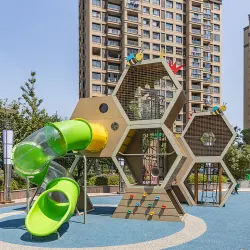Key features and considerations related to playground equipment
2024-01-20
Playground equipment refers to structures, installations, and play features designed for children to engage in recreational and physical activities in outdoor or indoor play areas. These structures are designed to provide a safe and enjoyable environment for children to play, explore, and develop various skills. Playground equipment comes in a variety of forms and may include structures such as swings, slides, climbing frames, and more. Here are key features and considerations related to playground equipment:
1. Types of Playground Equipment:
- Swings: Suspended seats or platforms that allow children to swing back and forth.
- Slides: Incline structures that provide a sliding surface for children to descend.
- Climbing Structures: Various structures designed for climbing, such as climbing walls, nets, and ropes.
- Playhouses: Small structures resembling houses or castles where children can engage in imaginative play.
- Seesaws: A balanced plank or board that moves up and down with two children seated on opposite ends.
- Spring Riders: Mounted on springs, these animal-shaped or themed structures move when children ride them.
- Spinners: Platforms that rotate, providing a spinning experience for children.
- Monkey Bars: Horizontal bars for children to swing and traverse across.
2. Safety Standards:
- Compliance: Playground equipment should comply with safety standards and regulations to ensure the well-being of children.
- Surface Materials: The playground surface should use impact-absorbing materials, such as rubber mulch or safety tiles, to reduce the risk of injuries from falls.
3. Age-Appropriate Design:
- Separate Zones: Playgrounds may have separate zones or sections for different age groups, ensuring that equipment is suitable for the developmental stages of the children using it.
- Accessible Design: Inclusive playgrounds may include features that cater to children with diverse abilities.
4. Material Selection:
- Durable Materials: Playground equipment should be constructed from durable, weather-resistant materials to withstand outdoor conditions.
- Plastic, Metal, or Wood: Common materials used, each with its own advantages in terms of durability, aesthetics, and maintenance.
5. Installation and Maintenance:
- Professional Installation: Ensure that the equipment is installed by professionals according to safety guidelines.
- Regular Inspection: Conduct regular inspections to identify and address any wear, damage, or potential safety hazards.
- Maintenance Schedule: Follow a maintenance schedule to keep the equipment in good condition.
6. Accessibility and Inclusion:
- ADA Compliance: Consideration for Americans with Disabilities Act (ADA) guidelines to make playgrounds accessible to children with disabilities.
- Inclusive Features: Playground designs may incorporate inclusive features, such as ramps, sensory elements, or adaptive swings.
7. Educational and Sensory Elements:
- Educational Panels: Some playgrounds include panels with educational content or activities.
- Sensory Play: Incorporate elements that stimulate the senses, such as textured surfaces, musical features, or sensory gardens.
8. Shade and Seating:
- Shade Structures: Provide shade structures or natural shading to protect children from the sun.
- Seating Areas: Include benches or seating areas for parents and caregivers.
9. Themed Playgrounds:
- Themed Designs: Some playgrounds are designed around specific themes, such as nature, fantasy, or adventure, adding an element of creativity and engagement.
10. Community Involvement:
- Input from Community: Involving the local community in the design and planning process can lead to a playground that meets the specific needs and preferences of the community.
- Fundraising and Sponsorship: Community efforts may involve fundraising or sponsorship to support the development and maintenance of playgrounds.
11. Supervision and Rules:
- Supervision: Encourage adult supervision, especially for younger children.
- Establish Rules: Display clear and age-appropriate rules to promote safe play.
Playground equipment plays a crucial role in the physical, social, and cognitive development of children. Well-designed and properly maintained playgrounds provide valuable opportunities for play, learning, and social interaction. Safety, inclusivity, and age-appropriate design are essential considerations in creating enjoyable and enriching play environments for children.



